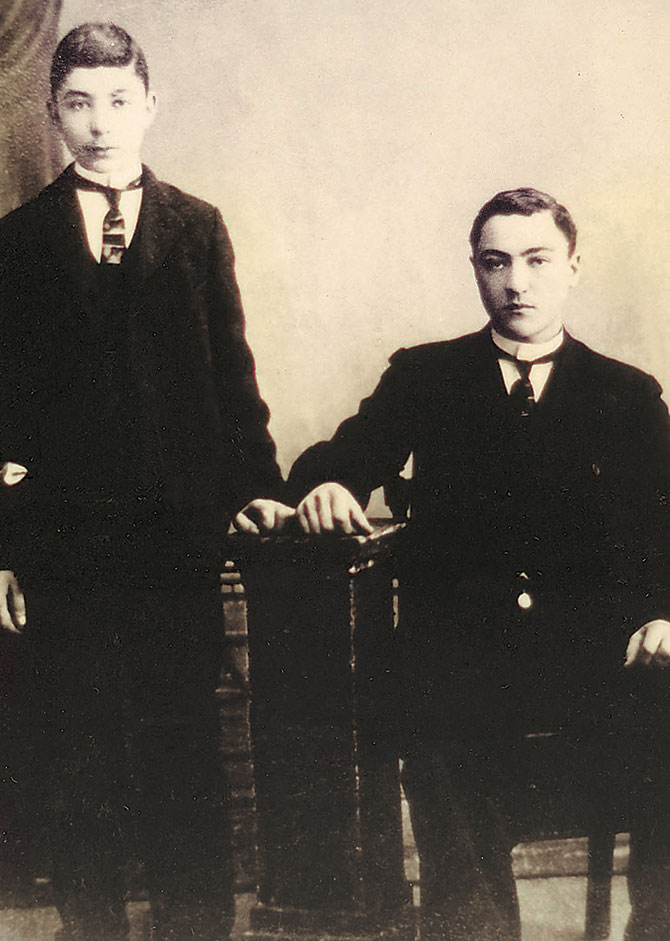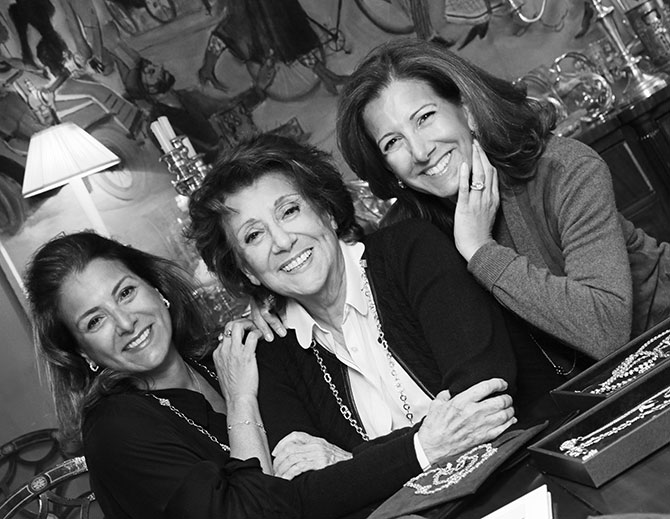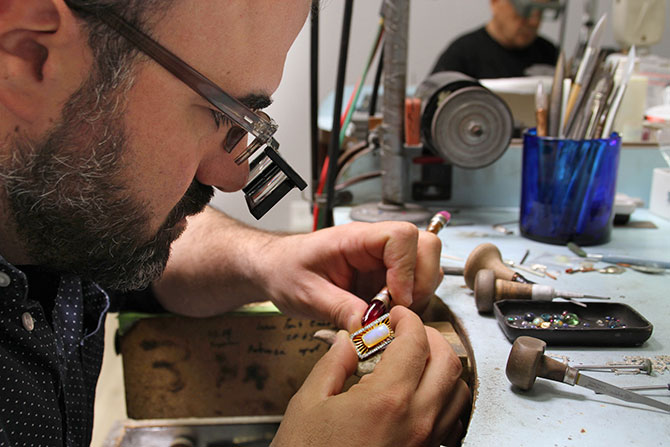The U.S. jewelry trade was built by an amalgam of immigrant groups whose legacies span multiple generations
As we celebrate JCK’s 150th anniversary, we’re also looking back on the origins of the American jewelry trade. The discussion is impossible to have without acknowledging the unique roles that Jewish, Armenian, and Indian immigrants played in the industry’s development.
Many of these individuals’ forebears fled persecution, political unrest, and wartime upheaval in their homelands. Others were motivated by the irresistible promise of new business prospects and the siren song of American culture, with its opportunities for growth and prosperity no matter how humble one’s beginnings.
One important thing these three groups have in common? Their ancestry is inextricably linked to jewelry, whether they were diamond merchants, bench workers skilled in the craftsmanship of an ancient trade, or gem-setters building on a heritage that could be traced all the way back to the networks of the Silk Road.
Diamonds and Beyond

The Jewish diamond merchants who established New York City’s jewelry district in the 1800s came largely from the diamond centers of Holland and Belgium, plus Germany and, later, parts of Eastern Europe. A persecuted group since the 15th century, Jews were “ousted from merchant guilds, and excluded from traditional brands of handicrafts,” notes Barak D. Richman in the spring 2006 edition of Law & Social Inquiry. “They thus were forced into becoming suppliers of finished goods and extenders of credit.”
Under such conditions, the diamond trade was an ideal profession. Gems are portable assets, something you can hide in your pockets if your surroundings suddenly become inhospitable or life-threatening, as was the case during the pogroms of the 19th and 20th century when Jews throughout the Russian Empire were intimidated, persecuted, and killed.
The religious violence, as well as the anti-Semitism that fueled it, reached a fever pitch around World War I and, most egregiously, in the years leading up to the Holocaust. Both events prompted waves of Jewish immigration to America. Many émigrés brought desirable skill sets pertaining not only to the diamond industry but also to the fabrication of fine jewelry, including the specialized tools required to make it.
That the Jewish jewelry community thrived in the United States speaks to the fact that “people find comfort in their own communities, and people want to support each other,” says Tom Heyman, third-generation partner at the century-old jewelry firm Oscar Heyman, founded by Latvian Jewish émigrés to New York City in 1912.
Like the Heymans, countless families belonging to the Jewish diaspora arrived on American shores and joined the jewelry trade over the past century and a half, building networks based on a tradition of trust in which deals were sealed with handshakes. These customs still shape the business today.
“Jewish knowledge of the jewelry industry dates back centuries, and those businessmen and women who are being innovative, and growing with the times, have continued to be a force,” says Ronnie VanderLinden, president of the Diamond Manufacturers & Importers Association of America (DMIA).
From Silk (Road) to Jewels

The first major wave of Armenian immigrants arrived in this country in the years immediately before and after the Armenian Genocide of 1915. The majority of those who escaped the massacres fled the Ottoman Empire (i.e., Turkey) and dispersed throughout the Middle East (Syria, Iran, and Lebanon) and Russia before coming to America. And it is no accident that many found work in the jewelry centers of New York and Los Angeles.
“Armenians are to jewelry what the Swiss are to watches,” says Pierre Akkelian, founder of the Armenian Jewellers Association and cofounder of the Armenian Jewellers Foundation. “Jewelry is in our DNA going all the way back to Mesopotamia, the cradle of Western civilization.”
“The Armenian kingdom was right in the middle of the Silk Road, which contributed to major growth of all kinds of trades, especially jewelry,” says L.A.-based jewelry designer Arman Sarkisyan, who, prompted by the collapse of the Soviet Union, moved to the United States from Armenia in 1990.
Some of the most successful Armenian-American jewelry families came here in the 1970s and ’80s. The Tacorians, who went on to found Tacori, came from communist Romania. The Karaguezians (of Kirk Kara) and the Ghanimians (of Simon G) were based in Lebanon, where they’d held prominent positions as jewelers in Beirut, then known as “the Paris of the Middle East.” The 1975–90 civil war pitting Lebanese Christians versus Lebanese Muslims forced many Armenian families to seek refuge—and a fresh start—in the well-established Armenian community in greater Los Angeles, including the enclaves of Pasadena and Glendale.

Myriam Gumuchian, a Belgian-born Armenian based in New York City, can trace her roots to Istanbul, where her family worked as diamond specialists. As owner of Gumuchian, celebrating its 40th anniversary this year, she believes the Armenians’ greatest contribution to the American jewelry business is its tradition of superb craftsmanship. “Their skills and expertise have been passed down from generation to generation,” she says. “Most Armenians by nature are very proud people, and they have a passion for making beautifully executed pieces. They are very good tradesmen and, thanks to that, have become successful businesspeople.”
Making the Cut
India’s long-standing role in the creation of precious jewels dates all the way back to the 16th-century founding of the Mughal Empire.
“Gold is such an integral part of India, and the artisans who made jewelry for royal families and private clients have always been essential to our stake in the jewelry industry,” says Parag Shah, president of the New York City–based third-generation diamond wholesaler Gem International and DMIA vice president and treasurer.
But India’s most significant role in America’s jewelry industry wouldn’t become clear until the 1960s and ’70s, when its Mumbai-adjacent diamond centers began to thrive and prosper. Diamond cutters who got in the game early on were in a great position to take their wholesale businesses to the next level, and many did so by establishing offices in New York and L.A. in the decades that followed. Having operatives stateside made it easy for early Indian diamantaires such as Eurogems Fine Jewelry, Gembel, Paras Diamond Co., and Sangam Diamond Corp. to transact with their U.S. clients, and their arrival in the States paved the way for others down the road.
The second wave of Indian immigration came in the wake of the Great Recession in 2008, when the need for low-cost gems and finished jewelry was at an all-time high. “Indian banks were lending money to Indian manufacturers, and that allowed them to buy rough diamonds very inexpensively,” Shah says. “They were able to make huge sums of money, and it allowed them to set up offices in the U.S. And there was money available to invest in more modern factories and more modern machinery to improve the quality of the product.”
In addition to their embrace of technology, Indian companies benefited from a built-in succession plan. Says Shah: “Sons and daughters come into the business automatically, so there’s a steady pool of talent.”
As well as the start of a new chapter in an immigrant tale as old as America.